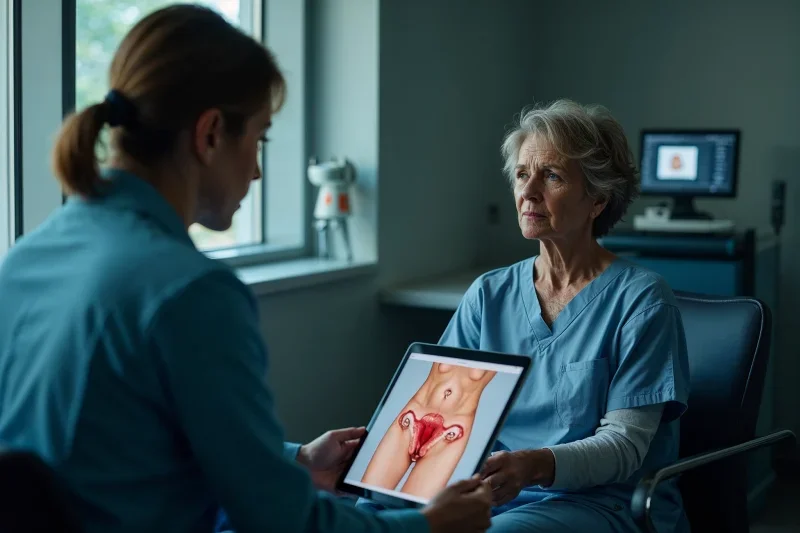Robotic Tubal Ligation Reversal: The Evolution of Surgical Precision
Categories:
By: Ethan Cole
Robotic surgery has evolved to enhance precision in procedures like tubal ligation reversal, translating surgeon movements into micro-movements.
The da Vinci Surgical System and similar technologies offer 3D visualization for detailed views and robotic arms for improved dexterity in surgery.
In robotic tubal ligation reversal, small, precise incisions are made, and the fallopian tubes are sewn with remarkable control, making it less invasive.
Robotic procedures significantly reduce recovery times and complications, including infection rates and blood loss, compared to traditional surgery methods.
The future of robotic surgery in fertility treatments promises further improvements in precision and efficiency, despite current limitations in costs and availability.
Introduction
Robotic tubal ligation reversal exemplifies advanced surgical precision. This technological innovation facilitates the safe reversal of tubal ligation through the use of small incisions and exceptional control, rendering it less invasive compared to traditional approaches. Enhanced visualization and precise robotic movements significantly reduce the risk of damage to surrounding tissues, minimize trauma, and contribute to faster recovery times. This advancement has considerably lowered the risks associated with surgery while improving overall success rates. As you continue through this informative overview, further insights into the development of robotic surgical techniques and their substantial benefits will be presented.
Understanding Tubal Ligation
In your journey towards fertility restoration, it is crucial to first understand what tubal ligation is. This surgical procedure, often called “getting your tubes tied,” is a form of permanent female sterilization. It involves the cutting, tying, or otherwise blocking of the fallopian tubes to prevent eggs from reaching the uterus for implantation.
Tubal ligation is highly effective, but like many decisions, it is not always permanent. You might have opted for this procedure earlier in life, but now find your circumstances have changed. Maybe you’ve remarried and want to have a child with your new spouse, or perhaps you’ve weathered the loss of a child and wish to conceive again. Regardless of the reasons, you’re now considering a reversal of your tubal ligation.
It’s important to note that not all types of tubal ligations are reversible. Factors such as the method used for your original procedure, your age, and your overall health can affect your chances of successful reversal and subsequent pregnancy. Your doctor can provide specific insights into your personal situation. Understanding tubal ligation is the first step to making an informed decision about your fertility future.
The Traditional Ligation Reversal Procedure
While you may feel overwhelmed by the prospect, understanding the traditional tubal ligation reversal procedure is vital. This process, also known as tubal reanastomosis, involves reconnecting the fallopian tubes to restore fertility.
Here’s the simple breakdown: you’re put under general anesthesia, making you unconscious and pain-free. Your surgeon then makes a small incision, or cut, near your belly button to access your fallopian tubes. Using special surgical tools, they remove the blocked portion of your tubes and rejoin the two healthy ends. They use tiny stitches that dissolve over time to secure the connection.
It’s essential you know that this surgery requires skill and precision. The tubes are delicate and only about a third of an inch wide. Additionally, the success of the procedure largely depends on the length of the healthy tube remaining. So, while it’s not always a guarantee, for many women, it’s a real chance to conceive naturally again.
Recovery is generally swift. You’ll likely be home the same day, and most women return to normal activities within a week. Remember that each person’s body responds differently, so it’s important to follow your doctor’s advice for best recovery.
Technological Advancements in Surgery
You’ve seen how traditional tubal ligation reversal procedures are performed. Now, let’s shift gears and consider how advancements in surgical technology are revolutionizing this process. From the evolution of surgical tools to the breakthroughs in robotic-assisted surgery, we’re heading towards a future of unprecedented precision in surgical procedures.
Evolution of Surgical Technology
Surgery’s evolution has been nothing short of miraculous. From the crude tools of ancient times to today’s sophisticated instruments, it’s been a journey marked by innovation and precision. You’ve seen this transformation firsthand, as procedures that once required large incisions and lengthy recoveries are steadily replaced with minimally invasive techniques.
The advent of laparoscopic surgery in the late 20th century was a game changer. Armed with small incisions and a camera, surgeons could now operate with unprecedented accuracy and minimal trauma to the patient. But that was just the beginning.
Now, imagine a world where surgical instruments can mimic the human hand’s dexterity, enabling complex procedures with even greater precision. That’s where technology like surgical robotics comes in. It’s a fast-evolving frontier that promises to revolutionize the way surgeries are performed.
But as exciting as these advancements are, they’re not without challenges. There’s a steep learning curve for surgeons and high costs to grapple with. However, the potential benefits, from reduced surgical complications to quicker patient recovery, make it a pursuit worth mastering. So, keep your eye on this space, as the evolution of surgical technology is far from over.
Robotic-Assisted Surgery Breakthroughs
Enter the world of robotic-assisted surgery, a cutting-edge field that takes surgical technology to new heights. You’ll find that the breakthroughs in this arena are nothing short of revolutionary, transforming the way surgeries, such as tubal ligation reversals, are performed.
One significant development includes robotic systems like the da Vinci Surgical System. This marvel allows surgeons to perform complex procedures with improved precision, flexibility, and control. You’ll benefit from smaller incisions, reduced risk of infection, and shorter recovery times.
In addition, breakthroughs in 3D visualization provide surgeons with a highly detailed, magnified view of the surgical site. This technology allows you to avoid the invasive techniques of the past and embrace a future of minimally invasive surgeries.
Further, enhanced dexterity is another boon of robotics in surgery. Robotic arms can mimic and even exceed the range of motion of a human hand, bypassing human limitations and reducing the risk of surgical errors.
Lastly, consider the impact of machine learning and artificial intelligence. These advancements are paving the way for future robotic systems capable of learning from past surgeries, continually improving their performance. All these breakthroughs are redefining the boundaries of surgical precision, leading to safer, more effective procedures.
Future of Precision Surgery
Imagine a world where surgeries are executed with unmatched precision, speed, and safety. This isn’t a sci-fi dream, it’s the future of precision surgery.
Upcoming technological advancements are pushing the boundaries of what’s possible. Virtual reality platforms, for instance, are transforming surgical planning. They’ll allow you to visualize anatomy in 3D, improving your understanding and surgical strategy. You’ll be able to practice complex procedures in a risk-free environment before you even touch a patient.
Artificial intelligence is another game-changer. AI algorithms are being developed to enhance decision making, predict outcomes, and even assist in real-time during surgery. You’ll have a digital partner, learning from every procedure and constantly improving.
There’s also the exciting prospect of nanotechnology. Imagine deploying microscopic robots into the body to perform repairs at a cellular level. It’s not here yet, but it’s on the horizon.
The evolution of surgical precision is accelerating, and you’re at the heart of it. Embrace these advancements, and you’ll not only improve your skills but also revolutionize patient care. The future of precision surgery is here, and it’s yours to master.
Introduction to Robotic Surgery
You’ve seen how technology has revolutionized various aspects of medicine, now let’s turn our attention to robotic surgery. This innovative field has evolved rapidly, enhancing precision in numerous procedures. We’ll also explore the unique advantages that robotic surgery brings to the operating table.
Evolution of Robotic Surgery
Robotic surgery has transformed dramatically over the past few decades. You’ve seen it shift from a concept in science fiction, to a radical innovation, and now to an integral part of modern surgical practice.
In the early days, robotic surgical systems were bulky, expensive, and limited in their capabilities. Yet, pioneers in the field weren’t daunted. They saw the potential for these machines to bring unprecedented precision and control to surgical procedures.
Throughout the years, continuous technological advancements have shaped the evolution of robotic surgery. Software has become more sophisticated, allowing for enhanced visualization and improved dexterity. Hardware, too, has evolved - robots are sleeker, more versatile, and easier to control than ever before. These changes have broadened the range of procedures that can be performed robotically, from simple biopsies to complex cardiac surgeries.
Yet, it’s not just about the technology. The evolution of robotic surgery also reflects changes in surgical education and training. Surgeons today are learning to operate these systems as part of their residency programs, ensuring they’re comfortable with this technology from the get-go.
Precision in Robotic Procedures
As we’ve journeyed through the evolution of robotic surgery, it’s clear that the advancements in software and hardware have led to a significant enhancement in the precision of robotic procedures. This precision is more than just a buzzword. It’s an operational principle that’s transforming the surgical landscape.
Precision in robotic surgery is about hitting the exact target, no more and no less. It’s about making surgical cuts that are millimeter-perfect, minimizing collateral tissue damage. Advanced computer algorithms guide the surgical robot’s arms, translating a surgeon’s hand movements into micro-movements. This level of control simply isn’t possible with the human hand alone.
Robotic systems also offer unparalleled vision. The 3D, high-definition view of the surgical field allows for better visualization of the anatomy, leading to more precise dissection and suturing. The robotic arms can rotate 360 degrees, providing flexibility that exceeds the human wrist’s capabilities.
Consider the implications. Imagine the magnitude of precision required for a procedure like tubal ligation reversal, where the fallopian tubes, mere millimeters in diameter, must be reconnected. Thanks to robotic surgery, this precision isn’t just possible, it’s becoming the norm. The future of surgical precision isn’t on the horizon; it’s already here.
Advantages of Robotic Surgery
Surgery’s cutting-edge world has been revolutionized thanks to robotics. You, as a medical practitioner or a potential patient, can reap the benefits of this technological advancement.
First off, precision is a pivotal advantage in robotic surgery. The robot’s hands, guided by a skilled surgeon, can make minute, delicate maneuvers reducing the risk of damage to surrounding tissues. You can’t ignore this remarkable accuracy.
Second, let’s talk about recovery. Robotic surgery is minimally invasive, which means smaller incisions. You’re looking at less trauma to the body, reduced blood loss, and minimized pain. Consequently, your recovery time is considerably shorter, and you’ll be back on your feet in no time.
Then, there’s the reduced risk of infection. Smaller wounds mean less exposure to potential pathogens. You’re less likely to deal with pesky post-op complications.
Lastly, you’ll appreciate the enhanced visualization. Surgeons have a three-dimensional, magnified view of the surgical site. This clear, closer perspective enhances their ability to perform complex procedures with precision, benefiting you immensely.
In the grand scheme, robotic surgery is a game-changer, promising a safer, quicker, and more precise surgical experience.
Robotic Tubal Ligation Reversal: An Overview
In the domain of fertility restoration, a new player has emerged: robotic tubal ligation reversal. This procedure, as its name suggests, uses a state-of-the-art robot-assisted surgical system to reverse a tubal ligation.
You’re probably familiar with tubal ligation—it’s a common method of female sterilization where the fallopian tubes are blocked or severed to prevent pregnancy. But what happens when you want to restore your ability to conceive naturally? That’s where the robotic tubal ligation reversal comes into play.
In the procedure, a surgeon uses the robot to make small, precise incisions in your abdomen. The robot’s arm is then manipulated to sew the tubes back together, a feat that requires remarkable precision and control. The surgery is less invasive than traditional methods, with lower risks of complications.
This isn’t science fiction, it’s the present. Robotic tubal ligation reversal is an example of how technology is shaping the future of fertility treatments. It’s a reflection of the progress we’re making in medical technology, and its potential to change lives in profound ways.
Benefits of Robotic Assisted Procedures
You might wonder, what’s the big deal about robotic assisted procedures? Well, let’s look at the benefits. With this technology, surgeons can perform with enhanced accuracy, you could potentially have a shorter recovery period, and there’s also a lower risk of complications.
Enhanced Surgical Accuracy
With robotic-assisted procedures, your surgeon gains an unprecedented level of accuracy. This isn’t merely an improvement; it’s a revolution in precision, allowing your surgeon to operate with a degree of detail that was previously unimaginable. The robotic system provides a three-dimensional view of the surgical field, magnified up to ten times. This means that everything is seen in startling clarity, allowing for exact movements and incisions.
But why should you care about this? Here’s why: precision in surgery isn’t just about making clean cuts. It’s about minimizing the risk of complications, reducing the chance of errors, and ensuring the best possible outcome for you. With robotic assistance, your surgeon can make minute adjustments that simply aren’t possible with the human hand alone.
Even the most skilled surgeon is subject to the limitations of the human body. Fatigue, hand tremors, even the natural limitations of human vision can impact surgical outcomes. Robotic assistance bypasses these limitations, providing a consistency and precision that’s simply unmatched. So, when it comes to your health, don’t you deserve the best that technology can offer?
Reduced Recovery Period
Often, one of the biggest benefits of robotic-assisted procedures like tubal ligation reversal is a reduced recovery period. This doesn’t mean you’ll bounce back immediately, but it does mean you’ll spend less time laid up in bed than you would after traditional surgery.
Robotic surgery is minimally invasive. Surgeons make smaller incisions, which means less trauma to your body. You’re less likely to need strong pain medication, and you’ll be up and about quicker. This doesn’t just mean getting back to work sooner. It means returning to your normal life, whether that’s playing with your kids, going for a jog, or simply enjoying a day out without discomfort or fatigue.
It’s important to remember, though, that ‘reduced’ doesn’t mean ‘eliminated’. You’ll still need to take it easy while you recover. Listen to your body, and don’t push yourself too hard too soon. But with robotic-assisted tubal ligation reversal, you can expect to be back on your feet faster than you might think. The reduced recovery period is a significant benefit, offering the potential for less disruption to your life.
Lower Complication Risk
Aside from the advantage of a quicker recovery period, another significant benefit of robotic-assisted tubal ligation reversal is the lower risk of complications. You’re likely familiar with the risks associated with traditional open surgery: infection, excessive bleeding, and adverse reactions to anesthesia. Thankfully, these risks are substantially diminished with robotic procedures.
Because the precision and control of the robotic system are unparalleled, there’s less trauma to your body. This means fewer incisions, reduced blood loss, and a lower likelihood of infection. It’s not just about the immediate post-operative period, either. Complications can occur weeks or even months after surgery, but with robotic assistance, these longer-term issues are less likely to surface.
Furthermore, the enhanced visualization provided by the robotic system allows surgeons to avoid unintended damage to surrounding tissues. This translates to less post-operative pain and a reduced need for pain medication, which in turn decreases the risk of opioid dependency.
Risk Factors and Considerations
When considering a robotic tubal ligation reversal, it’s essential to be aware of potential risk factors. Despite the precision and advanced technology, there are still considerations to remember.
You need to be aware that the success of the procedure relies heavily on your age and overall health. Younger women with good general health typically have higher success rates. Additionally, the type of tubal ligation you underwent initially can affect the outcomes. Certain methods, like those involving the removal of a large portion of the fallopian tube, might limit the success of a reversal.
Robotic surgery, while minimally invasive, is not without risks. Complications can occur, such as infection, bleeding, or damage to surrounding organs. You might also experience adverse reactions to anesthesia.
Another significant consideration is the risk of ectopic pregnancy after reversal. This is a condition where the fertilized egg implants outside the uterus, usually in the fallopian tube. It’s a serious complication that requires immediate attention.
Lastly, remember that even after a successful reversal, pregnancy is not guaranteed. Various factors, including male fertility, can influence conception.
Comparing Robotic and Traditional Methods
Without a doubt, you might be wondering how robotic tubal ligation reversal stacks up against the traditional method. Well, let’s explore that.
The robotic method is a game-changer. It offers unmatched precision, reduces human error, and provides a 3D view of the surgical field. You’re not just getting a procedure, you’re reaping the benefits of cutting-edge technology. However, it’s not perfect. Its higher cost might be a sticking point for some, and as a relatively new technique, it’s not as widely available as the traditional method.
On the other hand, the traditional method has its merits. It’s time-tested, widely available, and typically less costly. However, it also has drawbacks. It’s more invasive, recovery time is usually longer, and there’s a higher risk of complications due to human error.
Patient Testimonials and Success Stories
Real-life success stories paint a vivid picture of the potential outcomes of robotic tubal ligation reversal. You’ve heard the clinical jargon, now let’s explore the human side of this technological advance.
Imagine Sarah, a 35-year-old woman yearning for another child after a previous tubal ligation. She decides to undergo robotic reversal, and within a year, she’s holding her newborn. Or consider Tom and Lisa, who’d given up hope after years of unsuccessful natural conception attempts. Post-reversal, they’re now proud parents of twins.
You’ll find countless endorsements like these, each one a proof of the effectiveness of robotic surgery. Patients often report less pain, quicker recovery times, and most importantly, successful pregnancies post-procedure. They’re amazed at the precision the robotic arm exhibits, the minimal incisions, and the faster return to normal life.
The Future of Robotic Surgery in Fertility Treatments
While success stories of the present day offer a glimpse into the impact of robotic surgery in fertility treatments, it’s the potential of what lies ahead that truly sparks excitement. You see, as technology advances, so does the precision and efficiency of these robotic procedures. With more research and development, we’re looking at a future where fertility treatments are more successful, less invasive, and more accessible.
Imagine a world where complex fertility procedures are performed with such precision, that recovery times are considerably reduced. Picture a scenario where these procedures are widely available, making fertility treatments accessible to all who need them. This is the future that robotic surgery promises.
However, it’s not just about the technology. It’s also about the people behind it. Future advancements will require highly trained surgeons, adept at harnessing this technology. We’re talking about a new breed of medical professionals: part surgeon, part technologist.
Conclusion
In conclusion, robotic tubal ligation reversal represents a remarkable leap forward in fertility restoration. This cutting-edge technology combines unmatched precision, reduced recovery times, and lower complication risks, making it an increasingly preferred option for patients seeking to conceive after tubal ligation. With innovations like the da Vinci Surgical System, the field has advanced far beyond traditional methods, offering hope to those yearning to expand their families.
While the procedure’s success depends on factors such as age, health, and the type of original tubal ligation, robotic surgery provides a safer, minimally invasive alternative with enhanced outcomes. It’s important to remember, however, that each patient’s journey is unique. Comprehensive consultations and careful planning are vital to ensure the best possible results.
The future of robotic surgery in fertility treatments holds even greater promise. As technology evolves and accessibility improves, these advancements will continue to transform the possibilities for patients. With the expert care and precision of Dr. Jason Neef, you’re in the best hands to embark on your path toward parenthood.
Call now to schedule an appointment with Dr. Jason Neef and explore your fertility options.
Call (817) 568-8731Categories:
Frequently Asked Questions
-
Tubal reversal, also known as sterilization reversal, is a surgical procedure to restore fertility by reconnecting the tubal segments after a tubal sterilization. Techniques like microsurgical tubal reanastomosis or robotic-assisted tubal reversal are used to ensure precise repair and restore tubal patency, increasing the chances of natural conception.
-
The robotic approach, such as robotic tubal anastomosis, uses remotely controlled robotic arms for enhanced precision. Compared to methods without robotic assistance, this technique minimizes scarring, improves the success rate of tubal reversal, and allows for faster recovery. Robotic technology also ensures accuracy in repairing the muscular layers of the tubal segments, which is crucial for restoring function.
-
Women with a strong desire for sterilization reversal and intact tubal length after their original tubal ligation are good candidates. Factors like proximal tubal health, the type of initial surgical sterilization, and overall reproductive health evaluated by an obstetrics and gynecology specialist play a significant role in determining eligibility.
-
Laparoscopic tubal reversal is less invasive and effective but requires significant surgical skill. Meanwhile, robotic-assisted laparoscopic techniques, such as the use of the Zeus robotic system, offer greater precision and faster recovery. Studies show better outcomes and higher pregnancy rates after tubal re-anastomosis when performed with robotic assistance.
-
Microsurgical tubal anastomosis is a refined surgical approach that carefully repairs the layers of the tubal segments to ensure proper alignment and tubal function is restored. This technique is effective for women with tubal factor infertility and those seeking a reversal of sterilization.
-
While the costs for robotic surgery may be higher than traditional methods, the benefits include increased safety, precision, and a higher pregnancy rate after tubal anastomosis. The advent of robotic-assisted tubal surgery has made procedures more efficient, with reduced risks and quicker recovery times.
-
ARisks include scarring, infection, and ectopic pregnancy, particularly if the distal tubal segment is damaged. However, modern techniques like robotic-assisted tubal reversal and microsurgical tubal anastomosis have significantly improved outcomes by enhancing surgical accuracy and reducing complications.
-
Surgeons with specialized robotic training can perform advanced techniques like robotic-assisted laparoscopic tubal anastomosis with greater precision. This ensures that the tubal anastomosis was performed effectively, leading to improved outcomes and higher pregnancy rates in women undergoing the procedure.
-
The American Society for Reproductive Medicine supports research on the safety and effectiveness of robotic techniques and other reproductive surgeries. Their guidelines have encouraged the adoption of innovative methods like laparoscopy or robotic surgery, which have improved fertility following tubal sterilization.
-
Yes, combining reversal and IVF is an option for women seeking the best possible outcomes. While tubal reversal surgery restores natural conception, IVF can address additional fertility challenges. This dual approach is particularly effective for women with tubal factor infertility or diminished ovarian reserve.











